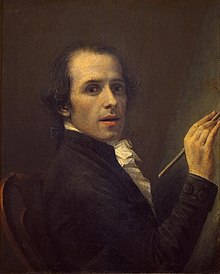
Back أنطونيو كانوفا Arabic انطونيو كانوفا ARZ Antonio Kanova Azerbaijani Антоніа Канова Byelorussian Антонио Канова Bulgarian Antonio Canova Breton Antonio Canova Catalan Antonio Canova Czech Antonio Canova Welsh Antonio Canova Danish
Antonio Canova | |
|---|---|
 Self-portrait, 1792 | |
| Born | Antonio Canova 1 November 1757 |
| Died | 13 October 1822 (aged 64) |
| Nationality | Republic of Venice (1757–1798) Austria (territory ceded to Austria) (1798–1805)[1] Kingdom of Italy (1805–1814) Austrian Empire (1814–1822) |
| Known for | Sculpture |
| Notable work | |
| Movement | Neoclassicism |
Antonio Canova (Italian pronunciation: [anˈtɔːnjo kaˈnɔːva]; 1 November 1757 – 13 October 1822) was an Italian Neoclassical sculptor,[2][3] famous for his marble sculptures. Often regarded as the greatest of the Neoclassical artists,[4] his sculpture was inspired by the Baroque and the classical revival, and has been characterised as having avoided the melodramatics of the former, and the cold artificiality of the latter.[5]
- ^ The fall of Venice occurred in 1797 but was then ceded later to Austria. Encyclopedia Britannica - Venice. Accessed 14 May 2018.
- ^ Irwin, David, "Antonio Canova, marchese d'Ischia | Italian sculptor", Britannica.com, retrieved 1 April 2017
- ^ "Canòva, Antonio nell'Enciclopedia Treccani", Treccani.it, retrieved 1 April 2017
- ^ Turner 1996a.
- ^ Jean Martineau & Andrew Robinson, The Glory of Venice: Art in the Eighteenth Century. Yale University Press, 1994. Print.
© MMXXIII Rich X Search. We shall prevail. All rights reserved. Rich X Search